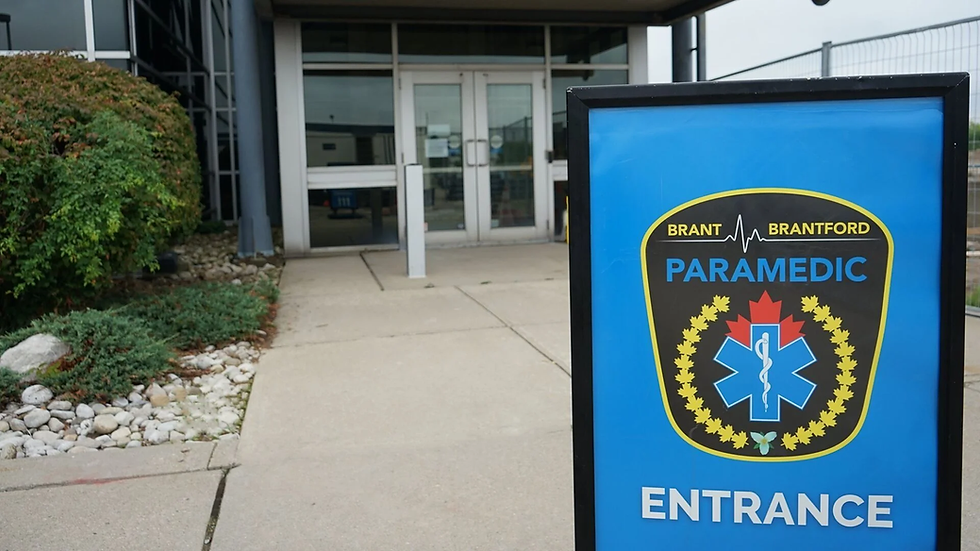Brant County and Brantford butt heads over paramedic budget
- Celeste Percy-Beauregard
- 4 days ago
- 4 min read

Celeste Percy-Beauregard
Local Journalism Initiative Reporter
Paramedic budget talks between the City of Brantford and County of Brant have stalled over less than $257,000.
The sticking point is whether to operate with the current level of service next year or a reduced level of service.
Potential savings work out to around $185,000 for the city and $72,000 for the county.
For years, the two have shared paramedic services. But multiple budget meetings last month involving the committee — made up of three members from each municipality — have ended without compromise.
“It’s a tough budget year,” committee chair, County of Brant Coun. David Miller, told his fellow councillors.
It’s not the first time the neighbouring municipalities have been at odds.
An attempt to restore a joint-services committee went south last year, and not long after, Brantford Mayor Kevin Davis threatened amalgamation, which the county has said it “unequivocally” opposes.
Davis and fellow Brantford committee members — councillors Greg Martin and Linda Hunt — were no-shows at a meeting on Sept. 29.
Because there wasn’t quorum, the budget couldn’t be finalized.
The meeting was called on short notice and there were “scheduling conflicts,” Maria Visocchi, the city’s communications director, told The Spectator.
“This was communicated to the clerk well in advance,” with the expectation the meeting would be rescheduled, she said.
However, Miller told his committee members only Davis had sent his regrets.
It left county representatives with concerns, because the service agreement says if the budget wasn’t finalized before Oct. 1, it would automatically default to the budget from the year before.
And there are significantly higher costs in 2026.
The proposed capital budget is nearly $1.3 million. But it’s the base operating budget of nearly $12.5 million that’s causing a hit.
It’s a 16.6 per cent increase over last year, largely driven by leases for a new headquarters and garage — both of which the committee had recommended and both councils approved, Miller pointed out.
A clause in the agreement allowed the county to request a budget extension from the city. Council will consider it at the next meeting on Oct. 14, Visocchi said.
But if they don’t accept, “then we go back to a budget that doesn’t work. It involves unions. It involves laying people off. It’s all kinds of things,” County of Brant Mayor David Bailey, who sits on the committee, told his council.
Since the paramedic service is used about 75 per cent of the time by city residents, the city pays for nearly three quarters of it.
About 42 per cent of the costs will be reimbursed by the Ministry of Health next year.
The proposed budget assumes the service will get six per cent more calls next year, the average annual increase it has seen across the last seven years.
Growth in the area, combined with an aging population and an “increasing propensity to call an ambulance,” have put the service under strain in recent years, according to a report the committee saw.
The service is currently operating with eight and a half ambulances, even though the committee approved a bump to nine as of July 1. The number of ambulances represents the amount of staff and hours that can be scheduled.
Davis suggested that a medical priority dispatch system (MPDS) the service is transitioning to in November could help address the volume of calls.
The Hamilton Central Ambulance Communication Centre is implementing the program and will administer it for Brant-Brantford.
The MPDS triages calls, meaning things like heart attacks and serious accidents would get an immediate response. If someone were to call for something that isn’t urgent, they could wait hours until an ambulance is free.
Outgoing paramedic chief Russell King said the program will help ensure people who need the ambulances most are getting them, but he doesn’t expect the call volume to decrease.
“All calls still need to have a response regardless of acuity,” noted a report that went to committee.
Still, Davis argued decisions made with a budget could “incentivize the staff and those who are managing the system” to do more to address the 10 to 15 per cent of calls that come through that likely don’t require an ambulance.
The service has made big gains after a rocky period.
In 2024, there were 224 incidents in a month where a local ambulance wasn’t available to respond to a call.
Known as “code zeroes,” it meant the service had to rely on ambulances in neighbouring districts, which adds to response time and costs.
The same year, the service lost more than 1,000 hours in a month, while paramedics waited at the emergency department to off-load patients.
The savings could come at the cost of the gains, according to the report.
County of Brant Coun. John Peirce questioned the effect it could have on the paramedics.
“They’re able to take a lunch (break) now. The morale is going up. I don’t want to do anything to change that and send it the other direction,” he said.
Celeste Percy-Beauregard’s reporting is funded by the Canadian government through its Local Journalism Initiative.




Comments